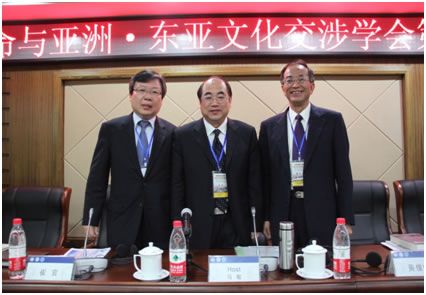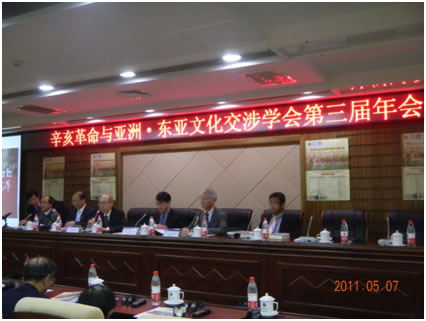Journal of Cultural Interaction in East Asia Vol.3 ―Table of Contents
Preface
| Address at the opening Session of the Third Annual Meeting at Huazhong Normal University on May 7, 2011 (MA Min) | detail |
Articles
| The Regional Structure of the 1911 Revolution: The North and the South in Chinese History (MURATA Yūjirō) | detail |
| The 1911 Revolution and the Korean Independence Movement: The Road to Democratic Republicanism (KIM Bong-jin) | detail |
| Gained in Translation: Ezra Pound, Hu Shi, and Literary Revolution (Jenine HEATON) | detail |
Opinion Forum
| Ideals and Reality: Sun Yat-sen’s Dream for Asia (ZHANG Kaiyuan) | detail |
| Dr. Sun Yat-sen’s Pan-Asianism Revisited: Its Historical Context and Contemporary Relevance (HUANG Chun-chieh) | detail |
| Huang Xing and Traditional Chinese Culture (XIAO Zhizhi) | detail |
Research Trends
| Zhang Peiheng’s A New History of Chinese Literature and Its Japanese Translation (CHEN Zhenghong) | detail |
| Manchu Studies in Korea (CHOE Yongchul) | detail |
Book Reviews
| Ge Zhaoguang, Zhai zi Zhongguo: Chongjian youguan “Zhongguo” de lishi lunshu (Dwelling Here in China: Reconstructing the History of the Concept of China) by SUN Weiguo | detail |
| Matsuura Akira, Kinsei Higashi Ajia kaiiki no bunka kōshō (Cultural Interactions in Maritime East Asia during Premodern Times) by WANG Zhenping | detail |
| Uchida Keiichi, Bunka kōshō gaku to gengo sesshoku: Chūgoku gengogaku ni okeru shūen kara no apurōchi(Cultural Interaction Studies and Linguistic Contact: The Peripheral Approach in Chinese Linguistics)by SATO Haruhiko | detail |
| Liu Yuebing, Riben jinxiandai sixiangshi(A History of Modern Japanese Thought)by WU Guanghui | detail |
Introduction of Major Institutions
| The Institute of Oriental and Occidental Studies at Kansai University (關西大學東西學術研究所) | detail |
| Institute of International Maritime Affairs at Korea Maritime University (韓國海洋大學校國際海洋問題研究所) | detail |
| The Research Institute of Korean Studies at Korea University (高麗大学校韓國學研究所) | detail |
| Research Center for Nonwritten Cultural Materials at Kanagawa University (神奈川大學非文字資料研究中心) | detail |
| Japanese Research Institute at Nankai University (南開大學日本研究所) | detail |
| The East Asian Cultural Research Team of the Research Center for International Japanese Studies at Hosei University (法政大学国际日本学研究所东亚文化研究课题组) | detail |
Contribution Guidelines
| Contribution Guidelines | detail |
Journal for Cultural Interaction in East Asia Vol.3

A commemorative photo after the opening session of the Third Annual Meeting in Wuhan, on May 7, 2011.

A commemorative photo of the change of president. From Left: Vice President Choi Gwan, President Ma Min, Ex-President Huang Chun –chie.
Preface: Address at the opening Session of the Third Annual Meeting at Huazhong Normal University on May 7, 2011
MA Min
The Regional Structure of the 1911 Revolution: The North and the South in Chinese History
MURATA Yūjirō
Key words: nation-state, the 1911 Revolution, ethnic groups, Liang Qichao, Yang Du
The 1911 Revolution was a great political event marking the beginning of a new era in modern Chinese history. Yet as the end of 2,000 years of dynastic rule (imperial politics), it also has long-term historical significance that can be felt even in the present. Today, a century after the 1911 Revolution, we need to look at this event from a macro perspective, on a scale of centuries and millennia, in order to fix its place in Chinese history. In other words, we need to reexamine the significance of the modern in the full sweep of Chinese history by looking at the 1911 Revolution. This will involve critically reexamining not only the 1911 Revolution but also perceptions and theories of modern Chinese history. From the perspective of these issues, in this essay I would like to present my views of the historical significance of the 1911 Revolution as seen from changes in the regional structure of Chinese history.
 Download[English](PDF)
Download[English](PDF)
The 1911 Revolution was a great political event marking the beginning of a new era in modern Chinese history. Yet as the end of 2,000 years of dynastic rule (imperial politics), it also has long-term historical significance that can be felt even in the present. Today, a century after the 1911 Revolution, we need to look at this event from a macro perspective, on a scale of centuries and millennia, in order to fix its place in Chinese history. In other words, we need to reexamine the significance of the modern in the full sweep of Chinese history by looking at the 1911 Revolution. This will involve critically reexamining not only the 1911 Revolution but also perceptions and theories of modern Chinese history. From the perspective of these issues, in this essay I would like to present my views of the historical significance of the 1911 Revolution as seen from changes in the regional structure of Chinese history.
 Download[English](PDF)
Download[English](PDF)The 1911 Revolution and the Korean Independence Movement: The Road to Democratic Republicanism
KIM Bong-jin
Key words: relationship, (Chinese) revolution, (Korean) independence movement, republicanism, Confucianism
 Download[English](PDF)
Download[English](PDF)
 Download[English](PDF)
Download[English](PDF)Gained in Translation: Ezra Pound, Hu Shi, and Literary Revolution
Jenine HEATON
Key words: Haiku, Imagism, Ezra Pound, Hu Shi, Baihua Movement
 Download[English](PDF)
Download[English](PDF)
 Download[English](PDF)
Download[English](PDF)Ideals and Reality: Sun Yat-sen’s Dream for Asia
ZHANG Kaiyuan
Key words: Sun Yat-sen, the Principle of Nationalism, cosmopolitanism, awakening of human nature
When planning China’s future revolution, Sun Yat-sen at one time used the model of the West. Since China is after all a part of Asia, however, and as his understanding of the corrupt and critical state of the Western system of capitalism grew, he eventually looked once again to Asia. He advocated collaborating with Japan, and approved of allying with various oppressed peoples in Asia. He planned to join forces with other Asian nations in order to stop Western encroachment in Asia. He divided the world into two major categories: the oppressors and the oppressed. He sought independence, equality, prosperity, and power for the oppressed, and proposed a new world order of peace and justice. He considered nationalism to be the basis of cosmopolitanism. Only by restoring national equality to the oppressed nations would those nations be able to move toward cosmopolitanism. For Sun, societies should deal appropriately with the relationship between cosmopolitanism and nationalism, both of which necessarily were to endure profound, universal judgment from people around the world. Humankind was to reawaken and rally together to help their own respective cultures. China’s traditional morality was to spread to merge with the morally good elements of every country in the world, creating the foundation for building a new world citizen morality.
 Download[English](PDF)
Download[English](PDF)
When planning China’s future revolution, Sun Yat-sen at one time used the model of the West. Since China is after all a part of Asia, however, and as his understanding of the corrupt and critical state of the Western system of capitalism grew, he eventually looked once again to Asia. He advocated collaborating with Japan, and approved of allying with various oppressed peoples in Asia. He planned to join forces with other Asian nations in order to stop Western encroachment in Asia. He divided the world into two major categories: the oppressors and the oppressed. He sought independence, equality, prosperity, and power for the oppressed, and proposed a new world order of peace and justice. He considered nationalism to be the basis of cosmopolitanism. Only by restoring national equality to the oppressed nations would those nations be able to move toward cosmopolitanism. For Sun, societies should deal appropriately with the relationship between cosmopolitanism and nationalism, both of which necessarily were to endure profound, universal judgment from people around the world. Humankind was to reawaken and rally together to help their own respective cultures. China’s traditional morality was to spread to merge with the morally good elements of every country in the world, creating the foundation for building a new world citizen morality.
 Download[English](PDF)
Download[English](PDF)Dr. Sun Yat-sen’s Pan-Asianism Revisited: Its Historical Context and Contemporary Relevance
HUANG Chun-chieh
Huang Xing and Traditional Chinese Culture
XIAO Zhizhi
Zhang Peiheng’s A New History of Chinese Literature and Its Japanese Translation
CHEN Zhenghong
Manchu Studies in Korea
CHOE Yongchul
Book Reviews
-Ge Zhaoguang, Zhai zi Zhongguo: Chongjian youguan “Zhongguo” de lishi lunshu(Dwelling Here in China: Reconstructing the History of the Concept of China)by SUN Weiguo
- Matsuura Akira, Kinsei Higashi Ajia kaiiki no bunka kōshō(Cultural Interactions in Maritime East Asia during Premodern Times)by WANG Zhenping
- Uchida Keiichi, Bunka kōshō gaku to gengo sesshoku: Chūgoku gengogaku ni okeru shūen kara no apurōchi(Cultural Interaction Studies and Linguistic Contact: The Peripheral Approach in Chinese Linguistics) by SATO Haruhiko
- Liu Yuebing, Riben jinxiandai sixiangshi(A History of Modern Japanese Thought) by WU Guanghui
 Download[English](PDF)
Download[English](PDF)
- Matsuura Akira, Kinsei Higashi Ajia kaiiki no bunka kōshō(Cultural Interactions in Maritime East Asia during Premodern Times)by WANG Zhenping
- Uchida Keiichi, Bunka kōshō gaku to gengo sesshoku: Chūgoku gengogaku ni okeru shūen kara no apurōchi(Cultural Interaction Studies and Linguistic Contact: The Peripheral Approach in Chinese Linguistics) by SATO Haruhiko
- Liu Yuebing, Riben jinxiandai sixiangshi(A History of Modern Japanese Thought) by WU Guanghui
 Download[English](PDF)
Download[English](PDF)Introduction of Major Institutions
- The Institute of Oriental and Occidental Studies at Kansai University
(關西大學東西學術研究所)
- Institute of International Maritime Affairs at Korea Maritime University
(韓國海洋大學校國際海洋問題研究所)
- The Research Institute of Korean Studies at Korea University
(高麗大学校韓國學研究所)
- Research Center for Nonwritten Cultural Materials at Kanagawa University
(神奈川大學非文字資料研究中心)
- Japanese Research Institute at Nankai University
(南開大學日本研究所)
- The East Asian Cultural Research Team of the Research Center for International Japanese Studies at Hosei University
(法政大学国际日本学研究所东亚文化研究课题组)
 Download[English](PDF)
Download[English](PDF)
(關西大學東西學術研究所)
- Institute of International Maritime Affairs at Korea Maritime University
(韓國海洋大學校國際海洋問題研究所)
- The Research Institute of Korean Studies at Korea University
(高麗大学校韓國學研究所)
- Research Center for Nonwritten Cultural Materials at Kanagawa University
(神奈川大學非文字資料研究中心)
- Japanese Research Institute at Nankai University
(南開大學日本研究所)
- The East Asian Cultural Research Team of the Research Center for International Japanese Studies at Hosei University
(法政大学国际日本学研究所东亚文化研究课题组)

 Download[English](PDF)
Download[English](PDF)


 English
English 日本語
日本語